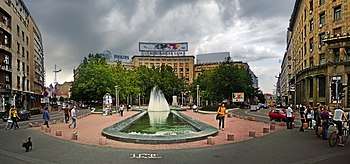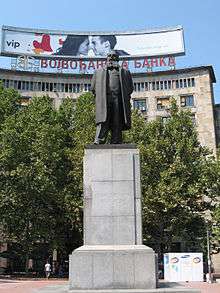Nikola Pašić Square
| Nikola Pašić Square Трг Николе Пашића | |
|---|---|
| Urban neighbourhood | |
 Nikola Pašić Square in June 2009. | |
 Nikola Pašić Square Location within Belgrade | |
| Coordinates: 44°48′45.7″N 20°27′46.6″E / 44.812694°N 20.462944°ECoordinates: 44°48′45.7″N 20°27′46.6″E / 44.812694°N 20.462944°E | |
| Country |
|
| Region | Belgrade |
| Municipality | Stari Grad |
| Time zone | UTC+1 (CET) |
| • Summer (DST) | UTC+2 (CEST) |
| Area code | +381(0)11 |
| Car plates | BG |
Nikola Pašić Square (Serbian: Трг Николе Пашића/Trg Nikole Pašića) is one of the central town squares and an urban neighborhoods of Belgrade, the capital of Serbia. The square is named after Nikola Pašić who served as mayor of Belgrade, prime minister of Serbia and prime minister of Yugoslavia. Until 1992 the square was named Square of Marx and Engels (Serbian: Трг Маркса и Енгелса, Trg Marksa i Engelsa).
Location
Located in the municipality of Stari Grad, Nikola Pašić Square lies in downtown Belgrade as the direct extension of Terazije. Named after Nikola Pašić, Serbia's famous early 20th century politician and Prime Minister, it overlooks the monumental building of the National Assembly and itself extends into Belgrade's longest street, Bulevar kralja Aleksandra, while Dečanska Street connects it to the Republic Square.
History and characteristics
The square was built during the 1950s as part of a massive Terazije reorganization project. Inaugurated as the Marx and Engels Square in honour of the famous communist theoreticians, its original terrain was so hilly that lots of earth had to be removed in order to make its construction possible.
Subsequently, in the late 1980s, it was one of the Belgrade's first toponyms to change its name with the closing of the era of Socialist Yugoslavia.
Characteristics

A monument to Nikola Pašić was erected in the early 1990s. When the statue was to be erected, ideas of bringing back earth to the square in order to create the artificial hillock as a pedestal for the monument appeared, but were ultimately abandoned.
The dominant architectural features in the square are the massive "Dom sindikata" building and one of the Belgrade's largest fountains. Museum of Yugoslav History is located across the fountain. Adjacent to the square is the Pioneers Park as well as the buildings of the Belgrade City Hall and the Presidency of the Republic.
The pedestrian section of the square is used for various public events, most notably open flower, honey, and book sales. On occasion, artificial ice rink or beach volley sand courts are put up as seasonal attractions in winter and summer, respectively.
Features
Dom Sindikata
Dom Sindikata ("Trade Union Hall") is a massive building, built in the style of Socialist realism. It was projected by Branko Petričić and the construction began in 1947. It was finished by the Russian construction workers from 1953 to 1957. That year the first seminar was held and on 18 November 1957 the first musical show. The Great Hall with 1,600 seats, became one of the central entertainment multi-purpose venues in Belgrade (concerts, shows, cinema). Conductor Mladen Jagušt stated that the hall is one of the five in Europe with the best acoustics. In the 1970s and 1980s it became a prestigious scene, Belgrade's version of Paris Olympia. A massive reconstruction ensued in 1978 when the interior of the entry hall was remodeled. In time it became the multiplex, with additional halls 2 (305 seats), 3 (105) and 4 (101), with the total area of 6,250 m2 (67,300 sq ft). In 2013 the building was declared a cultural monument. In July 2017 the facility was closed for the impending complete reconstruction, projected to last up to 8 months. Due to the protected status, the overall appearance has to be preserved. The unique marble floor, banisters and handrails will be repaired and with he help of the vintage photos, the "old feel" will be kept. After the reconstruction, it will have five halls with additional venues, while the Great Hall will be reducted to 1,300 seats and will still be the largest concert hall in Belgrade.[1][2]
The building is designed in the manner of socialist realism, with the influences of the late modernism. In terms of architecture, it is the symbol of the construction immediately after the war, and with its position and volume, it permanently set the outline of the square, which itself is one of the most important public spaces in Belgrade. Apart from architectural values, the building is important from the cultural and historical point of view, as many important political and cultural events happened in Dom Sindikata. For all that, it was declared a cultural monument in April 2013.[3]
Bezistan
Bezistan is a shopping area in an indoor passage which connects Terazije and the Square of Nikola Pašić. Originally, it was a location of Hotel "Pariz", which was built in 1870 and demolished in 1948 during the reconstruction of Terazije. Passage has been protected by the state as a "cultural property", though still under the "preliminary protection", and was nicknamed by the architects as the "belly button of Belgrade".[4] It is part of the wider protected Spatial Cultural-Historical Unit of Stari Grad.[5]
Since the 1950s, the covered square was a quiet corner in sole downtown, with mini gardens and coffee shops and a popular destination of many Belgraders, but in the recent decades mainly lost that function. In 1959 a round plateau with the fountain and a bronze sculpture, called “Girl with the seashell”, sculptured by Aleksandar Zarin, was built. A webbed roof, shaped like a semi-opened dome, made of concrete and projected by Vladeta Maksimović, was constructed to cover the plateau and the fountain. Because of that feature, and a small shops located in it, it was named "Bezistan", though it never functioned as the bezistan in its true, oriental sense of the term. Revitalization and reconstruction was projected for the second half of 2008, but the only work that has been done was the reconstruction of the plateau and the fountain in 2011.[5][6]
Bezistan covers an area of 13,667 m2 (147,110 sq ft).[6] The major feature within Bezistan was the "Kozara" cinema, one of the most popular in Belgrade for decades. It was closed in 2003, purchased by Croatian tycoon Ivica Todorić and allegedly planned as a supermarket for Todorić's Serbian brand "Idea" before it was destroyed by fire on 25 May 2012[7][8] It has been left in that condition ever since. Bezistan had candy and souvenir shops on one side, and modernistic section on other side, with McDonald's restaurant, modern coffee shop and "Reiffeisen bank", but as of 2018 it looks like nothing more than a neglected, empty passage. New possible reconstruction was announced in April 2017,[6] followed by a series of postponing: for October 2017, January, March and May 2018. The project includes new paving of the area and reintroduction of the greenery.[5]
Birds
The square's open space attracts various bird species, among them: feral pigeon, house sparrow, hooded crow, European kestrel, and common swift. Furthermore, walking around the square, it is possible to hear great tit and woodpigeon sounds emanating from the nearby Pionirski Park. Large gulls regularly fly over the square at higher altitude. [9]
Gathering spot
1982 Palestinian solidarity rally
On 9 July 1982, the square, then named after Marx and Engels, was the site of a Palestinian solidarity rally. Named the "Rally of Solidarity with the Plight of the Palestinian People" and held under the 'Death to fascism, freedom to the people' mantra, the event was Yugoslav youth's protest against Israel's invasion of Lebanon as well as Israel's siege of Beirut. Organized by the Yugoslav Socialist Youth League (SSOJ), youth wing of SFR Yugoslavia's ruling political party — the Yugoslav Communist League (SKJ), the rally was held in front of 30,000 people. It featured speeches from the Yugoslav People's Army (JNA) general-lieutenant and Order of the People's Hero holder Dušan Korać as well as the Palestine Liberation Organization (PLO) representative in Yugoslavia, Mohammed Nephan. It also saw musical performances by Riblja Čorba, Električni Orgazam, Radomir "Točak" Mihailović, and Aki Rahimovski.[10]
References
- ↑ S.Čikarić (29 June 2017). "Rekonstrukcija za novi početak ruku" (in Serbian). Politika.
- ↑ Milan Janković (30 April 2012), "Direktor „dvorane zvezda" više od dve decenije", Politika (in Serbian)
- ↑ Daliborka Mučibabić (21 April 2013), "Prestonica bogatija za šest spomenika culture", Politika (in Serbian)
- ↑ Daliborka Mučibabić (26 March 2008), "Bezistan - Pepeljuga ili princeza" [Bezistan - Cinderella or princess], Politika (in Serbian), p. 23
- 1 2 3 Daliborka Mučibabić (24 March 2018). "Novi rok za lepši Bezistan" [New deadline for nicer Bezistan]. Politika (in Serbian). p. 15.
- 1 2 3 Daliborka Mučibabić (20 April 2017), "Bezistan bez kioska, a dobija klupe" [Bezistan without kiosk, new benches will be placed], Politika (in Serbian), p. 17
- ↑ B.Hadžić (25 May 2012), "Bioskop Kozara izgoreo do temelja" [Cinema Kozara burned to the ground], Večernje Novosti (in Serbian)
- ↑ S.Šulović (27 September 2013), "Beograd spao na 9 bioskopa" [Belgrade came down to only 9 cinemas], 24 sata (in Serbian), p. 3
- ↑ Ebird Hotspots
- ↑ P., B. (July 1982). "Rock koncert za Palestinu". Džuboks. Retrieved 23 November 2017.
External links
| Wikimedia Commons has media related to Nikola Pašić Square. |